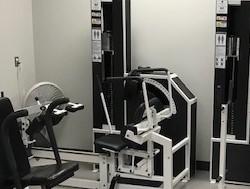The Lumbar Extension - by Matthew Romans
Posted May 23, 2019 by Matthew RomansThe leading cause of missed days from work is lower back pain. This can occur as a result of a traumatic injury, overuse injury, genetic abnormality, or most often simple muscular weakness. One of the most unique and vital machines we have at Total Results is the MedX Lumbar Extension, which addresses the lower back. It is virtually impossible to find anything like it in a commercial gym setting, and while other equipment manufacturers have tried to produce variations and facsimiles, nothing comes close to the engineering genius that went into producing this revolutionary piece of machinery. The primary muscles involved in this exercise are the erector spinae and multifidus muscles, those responsible for extension and rotation of the spine. As Arthur Jones, founder of Nautilus Equipment Corporation states, "To the degree that muscular weakness is a factor in spinal pathology, the most important muscles are the extensor muscles of the lumbar spine&" (from: The Lumbar Spine, The Cervical Spine, and the Knee - Testing and Rehabilitation)
Arthur Jones founded the Nautilus corporation in the 1960s and forever changed the field of exercise. While Nautilus manufactured many machines that involved the lower back musculature (such as the Hip & Back and Lower Back machines), there was no mechanism in place to lock in the pelvis and most effectively target the spinal erectors. As a result, these machines were not truly able to measure or inroad (fatigue) strength levels in this vital musculature without involving the thigh and hip structures.
When Jones sold Nautilus in 1986 and created the MedX corporation, he established the first truly valid means of strength testing. The centerpiece of the MedX testing equipment line was the MedX Medical Grade Lumbar Extension machine, complete with computer feedback. Total Results' MedX Exercise Lumbar Extension machines were built on this framework but have enhanced cams to more effectively match strength with resistance. This machine (and all MedX selectorized equipment) has a weight stack without guide rods, which virtually eliminates friction. There are three seat settings and an adjustable foot plate, to accommodate people of varying heights. The machine has padded knee restraints (to minimize involvement of the thighs) and a rotating sacral pad to minimize irritation as your spine extends. A seat belt will be snugly fastened to contain the pelvis and arrest reactionary force. The Lumbar Extension has a possible range of motion of 80 degrees, and there is a range limiter than can alter either your starting or ending position to enable a safe and pain-free range of motion.
To begin the Lumbar Extension exercise, your instructor will have you enter the machine by first sitting on the seat and then swinging your right foot across (this guards against unilateral loading of the spine and pelvis). The positioning of the foot plate and knee restraints will be dependent upon achieving an angle of between 120 and 130 degrees at the knee joint, with the knees on a slightly higher plane than the hips. Once the seat belt has been fastened and the knee restraints have been sufficiently tightened, the movement arm will be brought to its starting position. Generally we set the start position at 50 degrees on the range of motion protractor; this was arrived upon years ago at the advice of the late Gary Lindahl, who was a physical therapist and owner of a high intensity exercise studio in the San Francisco Bay Area of California. The client will lightly grasp the handles of the movement arm, and while keeping the shoulders relaxed and the head in neutral position, should gradually increase the amount of force applied to the pad across the shoulder blades to commence movement. A squeeze technique will be applied, beginning with the third repetition, by pressing the movement arm against the end point for a few seconds and then gradually easing out. Once momentary muscular failure and thorough inroad have been achieved, the movement arm will be slowly and safely returned to the bottom out position.
Regular exercise for the spinal erector muscles is essential for maintaining good posture and spinal health, especially as an increasing number of us spend more time sitting at work and in our daily commute. The mere act of performing the function of trunk extension opens up the space between the vertebrae, which helps to relieve compression and impingement, and can be of great benefit to those with conditions like disc herniation and sciatica. I believe this exercise should be performed at a minimum of once per week; our exercise protocol and equipment are the ideal combination to optimize your strength and make spinal surgery largely unnecessary.

